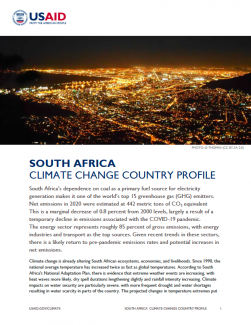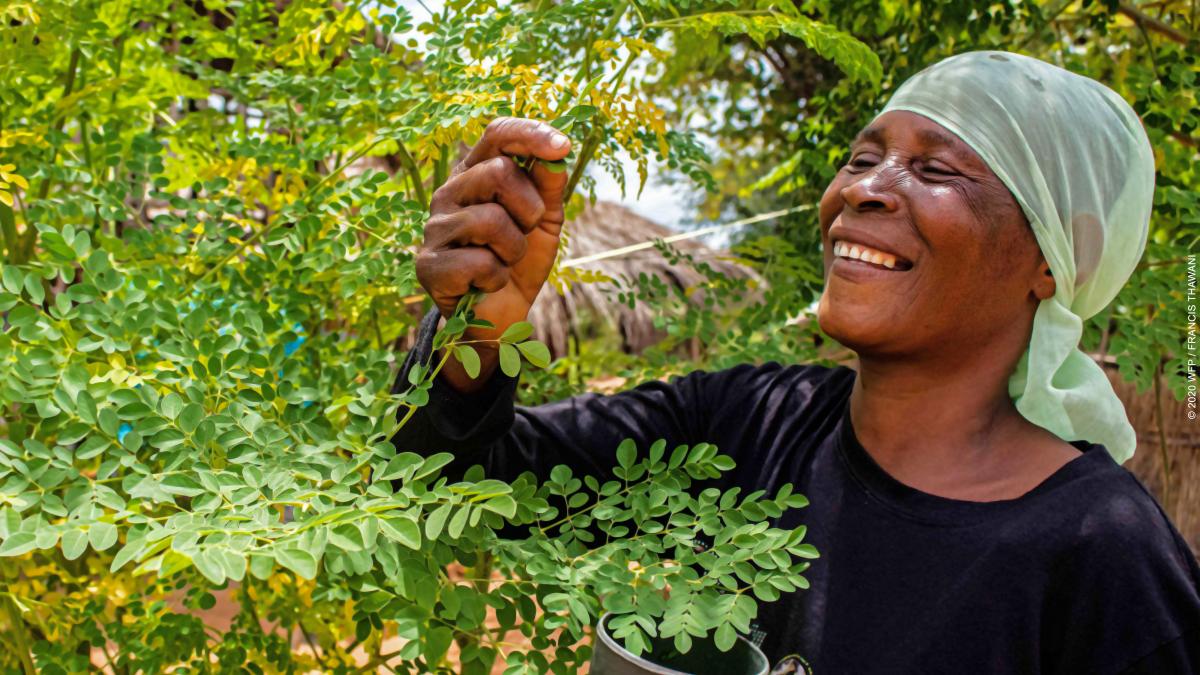Climate change is already altering South African ecosystems, economies, and livelihoods. Since 1990, the national average temperature has increased twice as fast as global temperatures. According to South Africa's National Adaptation Plan, there is evidence that extreme weather events are increasing, with heat waves more likely, dry spell durations lengthening slightly and rainfall intensity increasing. Climate impacts on water security are particularly severe, with more frequent drought and water shortages resulting in water scarcity in parts of the country. The projected changes in temperature extremes put additional strain on the health system, including the increasing disease burden, and affect aspects such as infrastructure, services, availability of medicines and medical supplies, and emergency services.
Government of South Africa Climate Priorities
South Africa’s climate priorities span climate adaptation and mitigation. The South African Cabinet has approved key climate actions, including creating a Presidential Climate Commission, South Africa’s Low Emissions Development Strategy, a National Climate Change Adaptation Strategy, a carbon tax, and a Just Transition Framework.
In its updated Nationally Determined Contribution, top adaptation goals included increasing institutional capacity, governance and legal frameworks; development of the scientific basis for strengthening the national and provincial governments’ readiness to respond; mobilizing funding for adaptation; and implementation of the 2020 National Climate Change Adaptation Strategy, which includes the objectives to 1) build climate resilience and adaptive capacity to respond to climate change risk and vulnerability; 2) promote the integration of climate change adaptation response into development objectives, policy, planning and implementation; 3) Improve understanding of climate change impacts and capacity to respond to these impacts; and 4) ensure resources and systems are in place to enable implementation of climate change responses.
South Africa refined its mitigation targets for 2025 and 2030, creating fixed-level target ranges for both years. Critical sectors identified for mitigation were: energy, waste, industrial processes and product use, agriculture, forestry, and other land use. At the United Nations Climate Change Conference (COP26), the U.S. government, together with the United Kingdom, France, Germany, and the European Union, announced a Just Energy Transition Partnership (JETP) with South Africa. The partnership aims to support South Africa’s accelerated energy transition away from coal—to chart a pathway for a low-carbon economy that achieves national climate goals. This partnership is a global first and could become a template for supporting a just transition worldwide.
The JETP political declaration committed to mobilizing an initial amount of approximately $8.5 billion from the five donors over three to five years through a combination of financial instruments, including multilateral and bilateral grants, concessional loans, guarantees, private investments, and technical support to enable the just transition. USAID, through Power Africa, received an additional $45 million in financing to support the JETP. Grant support will align with South Africa’s needs and priorities, as outlined in the JET Investment Plan, to support decarbonization of the energy sector, as well as to support communities and workers impacted by the transition from coal to renewable energy.
USAID’S Climate Change Program: Objectives and Results
USAID supports the Government of South Africa’s development and climate priorities through bilateral and regional programs and partnerships supporting climate adaptation and renewable energy.
Adaptation
USAID is building more resilient and water-secure southern African communities and ecosystems in one of the most climatically vulnerable regions in the world through improved management of transboundary natural resources and increased access to safe drinking water and sanitation services. USAID has helped:
- Support nearly 6,500 people to adapt to climate change across southern Africa in Fiscal Year 2021.
- Train South African National Parks managers and other stakeholders on Climate Risk Informed Decision Analysis, a collaborative climate impacts assessment tool for water resources.
- Improve 13 natural resources and protected areas management plans and policies across southern Africa to include climate adaptation actions to protect environmental resilience.
- Develop and implement climate- and biodiversity-smart agriculture to help communities adapt to climate change and related increased human-wildlife conflicts around rural food systems and water resources.
- Develop the Flood Forecasting Early Warning Systems to improve resilience within the Limpopo River Basin and its national member states, including South Africa.
- Enhance climate responsiveness in the water sanitation and hygiene (WASH) sector by improving the interpretation and integration of climate-related data and considerations into municipal water safety plans and processes.
Renewable Energy
USAID, in support of the Power Africa Initiative, is helping the Government of South Africa achieve its goal of shifting the power sector to 42 percent non-fossil fuel sources by 2030 and reducing overall GHG emissions in line with Paris Agreement targets. In partnership with national and sub-national authorities, USAID accelerates large-scale and distributed renewable energy deployment through technical assistance and capacity building. USAID has helped:
- Bring 27 procurements to financial close under the Renewable Energy Independent Power Producer Procurement Program, resulting in 2,200 megawatts (MW) of new renewable energy generation and approximately $4 billion in investment.
- Finance small-scale renewable energy projects through a 15-year (2016–2031), $200 million loan portfolio guarantee to South Africa’s Industrial Development Corporation.
- Support projects that will cut GHG emissions by nearly 860,000 metric tons by 2030.
- Develop a “green economy” reference library to support municipalities working on renewable energy, energy efficiency, financing clean energy, green transport, and solid waste management.
- Support South African municipalities with energy planning, renewable energy procurement, and improved revenue collection from electricity distribution.
Key USAID Programs
Direct capacity support to the Climate Change Branch at South Africa’s Department of Fisheries, Forestry, and Environment, to enhance the technical capacity of the South African government for low emissions development through the embedding of five Climate Change Monitoring Professionals for three years to support the compilation of South Africa’s National Greenhouse Gas inventories, including related financial monitoring, and global reporting responsibilities under the UNFCCC Paris Climate Agreement.
Southern Africa Energy Program:The United States Agency for International Development (USAID) Southern Africa Energy Program (SAEP or the Program) is a Power Africa initiative designed to provide technical advisory, capacity building and grant support to counterparts throughout Southern Africa, with the goal of increasing generation of and access to power throughout the region. ($75 million, 2017 - 2024).
Empower Southern Africa:The purpose of the ESA program is to increase the availability of and access to affordable, reliable, sustainable and clean energy in Southern Africa. ESA will provide combined support for both on-grid and beyond-the-grid efforts. This combined on- and beyond-the-grid approach will optimize USAID resources to more effectively provide targeted advisory services, catalytic grants, and investment mobilization to a range of energy sector institutions including government ministries, utilities, regulators, private sector energy companies and their trade groups, investors, multilateral organizations and initiatives, academic institutions and/or civil society. ESA will connect more African homes, businesses, and institutions to electricity on-the-grid and beyond-the-grid; reduce greenhouse gas emissions from the energy sector by supporting cleaner electricity generation delivered by the grid and accelerating distributed renewable energy (DRE); and, working in partnership with African governments, improve the enabling environment for energy sector investment and innovation. ($85 million, 2023 - 2028).
Power to the People: This activity will partner closely with the Government of South Africa’s renewable energy procurement program to support community engagement, local ownership, and trauma-informed approaches to deepen and sustain the impact of renewable energy companies’ investment in local communities.
For More Information




